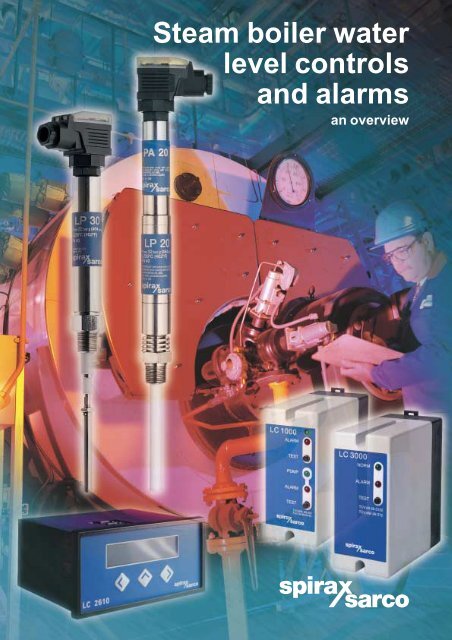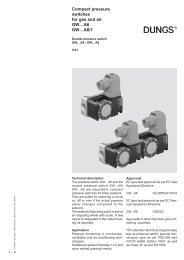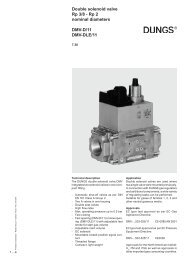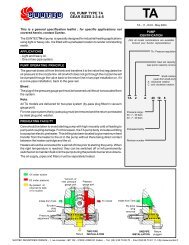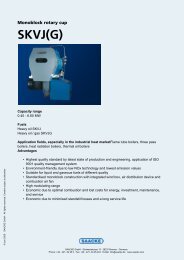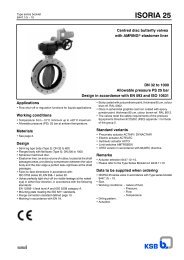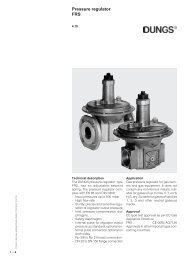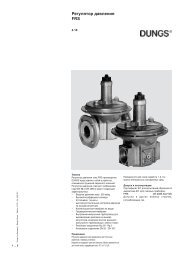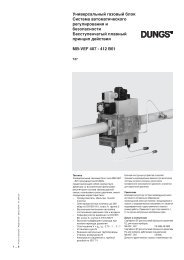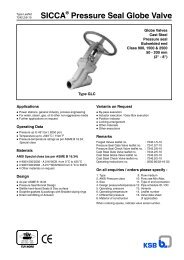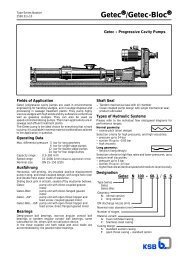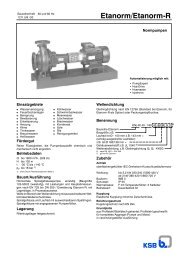Steam boiler water level controls and alarms - Filter
Steam boiler water level controls and alarms - Filter
Steam boiler water level controls and alarms - Filter
You also want an ePaper? Increase the reach of your titles
YUMPU automatically turns print PDFs into web optimized ePapers that Google loves.
<strong>Steam</strong> <strong>boiler</strong> <strong>water</strong><br />
<strong>level</strong> <strong>controls</strong><br />
<strong>and</strong> <strong>alarms</strong><br />
an overview
2<br />
This brochure gives an introduction to modern methods<br />
of steam <strong>boiler</strong> <strong>water</strong> <strong>level</strong> <strong>controls</strong> <strong>and</strong> <strong>alarms</strong>, <strong>and</strong><br />
outlines some of the systems available from Spirax Sarco.<br />
Significant developments in recent years have led to<br />
improved safety <strong>and</strong> reliability of <strong>boiler</strong> <strong>level</strong> <strong>controls</strong>,<br />
<strong>and</strong> Spirax Sarco is at the forefront of this technology.<br />
Modern electronic <strong>level</strong> <strong>controls</strong> are now commonplace,<br />
replacing older high maintenance float based devices.<br />
More detailed technical information is given in separate<br />
literature. Your local Spirax Sarco Engineer will be pleased<br />
to advise on the most suitable system for your application.<br />
Controls<br />
To achieve a steam output matched to the varying<br />
requirements of the average steam plant, good control<br />
of <strong>boiler</strong> <strong>water</strong> <strong>level</strong> is necessary. With the small steam<br />
spaces now common in modern <strong>boiler</strong>s, a quick <strong>and</strong><br />
accurate response to variations in <strong>water</strong> <strong>level</strong> is<br />
essential.<br />
On/off control<br />
<strong>Steam</strong> <strong>boiler</strong> <strong>water</strong> lev<br />
Why do I need <strong>boiler</strong> <strong>water</strong> <strong>controls</strong> <strong>and</strong> <strong>alarms</strong>?<br />
What methods are used to control the <strong>water</strong> <strong>level</strong>?<br />
Boiler <strong>water</strong> <strong>level</strong> is controlled either by switching the <strong>boiler</strong> feedpump on <strong>and</strong> off at <strong>water</strong> <strong>level</strong>s determined by<br />
a probe <strong>and</strong> controller (on/off control), or by progressively opening or closing a feed<strong>water</strong> valve as the steam<br />
dem<strong>and</strong> causes the <strong>water</strong> <strong>level</strong> to change in the <strong>boiler</strong> (modulating control).<br />
On/off control<br />
On/off control systems are most suitable for<br />
installations where a certain amount of variation<br />
in <strong>boiler</strong> pressure <strong>and</strong> steam flowrate can be<br />
tolerated. Examples might be smaller <strong>boiler</strong>s with<br />
stable load conditions.<br />
Feed<strong>water</strong> on / off<br />
Feedpump<br />
<strong>Steam</strong> flowrate<br />
from a <strong>boiler</strong> with<br />
on/off <strong>level</strong> <strong>controls</strong><br />
<strong>Steam</strong> flowrate<br />
1 PM<br />
13<br />
2 PM<br />
14<br />
3 PM<br />
15<br />
Water <strong>level</strong><br />
up <strong>and</strong> down<br />
Fuel Firing rate<br />
varies<br />
4 PM<br />
16<br />
5 PM<br />
17<br />
User benefits<br />
• Accurate safe control<br />
Choice of systems for all applications<br />
Approved by many authorities around the world<br />
All systems suitable for pressures up to 32 bar g<br />
On/off or modulating control to suit application<br />
Single, two, or three element control<br />
Alarms (limiters)<br />
In order to operate safely, all steam <strong>boiler</strong>s need a<br />
method of warning of excessively low or high <strong>water</strong><br />
<strong>level</strong>s. In many countries, regulations require two<br />
independent low <strong>water</strong> <strong>level</strong> <strong>alarms</strong>, or limiters.<br />
Independent high <strong>alarms</strong> are also required in many<br />
cases. With the move towards unmanned <strong>boiler</strong><br />
houses, there is an increasing need for high integrity<br />
self-monitoring <strong>alarms</strong>. These systems can operate<br />
with extended test intervals in many cases.<br />
Modulating control<br />
Modulating control gives a steady pressure <strong>and</strong><br />
steam flowrate in steam <strong>boiler</strong>s. The feed<strong>water</strong><br />
flowrate is varied, for example through a modulating<br />
valve, in response to changes in <strong>water</strong> <strong>level</strong>. With<br />
modulating control, the <strong>boiler</strong> feedpump is running<br />
all the time, <strong>and</strong> a spill-back line used to return<br />
unused feed<strong>water</strong> to the feed tank.<br />
Modulating control<br />
Feed<strong>water</strong><br />
valve<br />
Feed<strong>water</strong> flowrate<br />
matches<br />
steam dem<strong>and</strong><br />
Feedpump<br />
Spillback line<br />
<strong>Steam</strong> flowrate<br />
from a <strong>boiler</strong> with<br />
modulating <strong>level</strong> <strong>controls</strong><br />
1 PM<br />
13<br />
2 PM<br />
14<br />
<strong>Steam</strong> flowrate<br />
3 PM<br />
15<br />
4 PM<br />
16<br />
Water <strong>level</strong><br />
more steady<br />
Fuel<br />
Steady<br />
firing rate<br />
5 PM<br />
17
el <strong>controls</strong> <strong>and</strong> <strong>alarms</strong><br />
The majority of <strong>boiler</strong> <strong>level</strong> <strong>controls</strong> <strong>and</strong> <strong>level</strong> <strong>alarms</strong> operate on the principle of conductivity or capacitance, <strong>and</strong><br />
Spirax Sarco is the world leader in using these principles for safe accurate control of <strong>water</strong> <strong>level</strong>s in <strong>boiler</strong>s.<br />
Conductivity<br />
A conductivity probe (LP10-4) <strong>and</strong> controller can be<br />
used in a <strong>boiler</strong> or a tank for on/off pump control<br />
<strong>and</strong>/or alarm duties.<br />
It has one electrode for each function, which is cut to<br />
the required length on installation. Each probe<br />
electrode acts as a simple switch, indicating a low<br />
resistance to earth if in <strong>water</strong>, or a high resistance if<br />
out of <strong>water</strong>.<br />
For example, with a low alarm, the controller senses<br />
a change of resistance from low to high as the <strong>water</strong><br />
<strong>level</strong> falls below the probe tip. This change in<br />
resistance causes the controller to disengage a relay<br />
to operate an alarm bell, light, or both, <strong>and</strong> normally<br />
will also cut the power to the burner.<br />
Simple conductivity probes operate on this principle,<br />
<strong>and</strong> have no self-checking facility.<br />
High Integrity self-monitoring <strong>level</strong> <strong>alarms</strong> (limiters)<br />
(LP30 low alarm <strong>and</strong> LP31 high alarm probes)<br />
operate on this same conductivity principle. The<br />
probes are designed to detect numerous failure<br />
modes <strong>and</strong> will, for example, sound an alarm if the<br />
wiring is damaged. The controller has a cyclic selftest<br />
facility which sounds an alarm if it fails to react<br />
to a simulated fault. Boilers fitted with <strong>alarms</strong> of this<br />
type in the <strong>boiler</strong> shell can operate with extended<br />
test intervals in most countries, in many cases<br />
allowing the <strong>boiler</strong> house to be de-manned.<br />
LP10-4 4-tip<br />
conductivity probe-<br />
On / off <strong>level</strong> control <strong>and</strong><br />
simple high <strong>and</strong> low <strong>alarms</strong>.<br />
An additional low alarm would<br />
be needed for a <strong>boiler</strong>.<br />
(Protection tube not shown).<br />
High alarm<br />
Pump off<br />
Water <strong>level</strong><br />
Pump on<br />
Low alarm <strong>level</strong><br />
LP30 low alarm probe/limiter-<br />
Conductivity probe with comparator tip<br />
providing a high-integrity, self-monitoring<br />
low <strong>level</strong> alarm in a <strong>boiler</strong>.<br />
Conductivity or Capacitance?<br />
Comparator<br />
tip<br />
Capacitance<br />
A capacitance probe (LP20 with PA20 preamplifier)<br />
can be used in a <strong>boiler</strong> or a tank for modulating or<br />
adjustable on/off control. The probe consists of a<br />
conductive core completely sheathed in an insulating<br />
material. For this reason, capacitance probes cannot<br />
be cut to size, so are available in several different<br />
lengths. As the <strong>water</strong> <strong>level</strong> rises or falls, the<br />
capacitance coupling effect changes.<br />
A high or a low <strong>level</strong> alarm switching point can also<br />
be selected. Controllers are available for pneumatic<br />
or electrically actuated valves or variable speed<br />
pumps.<br />
Used as an on/off adjustable <strong>level</strong> control, it avoids<br />
having to cut probe tips to length, <strong>and</strong> permits <strong>level</strong><br />
adjustments to be made at the controller without<br />
having to remove the probe from the <strong>boiler</strong>.<br />
LP20/PA20<br />
capacitance probe-<br />
Providing modulating <strong>level</strong> control<br />
plus one of the <strong>alarms</strong> in a <strong>boiler</strong>.<br />
Additional alarm(s) would<br />
be needed.<br />
Boiler shell<br />
Protection tube<br />
Adjustable high<br />
or low <strong>level</strong> alarm<br />
Adjustable set point<br />
Valve closed<br />
Transmitter 100 %<br />
Valve open<br />
Adjustable<br />
proportional<br />
b<strong>and</strong><br />
Transmitter 0 %<br />
3
4<br />
How do I chose the best system for my particular application?<br />
Two system examples are shown below. Many other combinations may be used to comply with local/national<br />
regulations <strong>and</strong> specific customer applications. Additional literature is available which gives detailed technical<br />
information on each system <strong>and</strong> its components.<br />
Example 1:<br />
On/off <strong>level</strong> control with<br />
simple low <strong>and</strong> high <strong>level</strong> <strong>alarms</strong><br />
This system is suitable for a smaller <strong>boiler</strong>, or one<br />
where there is not a great variation in steam load,<br />
<strong>and</strong> is a common arrangement for supervised <strong>boiler</strong><br />
houses where daily testing is carried out. The probes<br />
may be mounted in side chambers, as shown, or in<br />
the <strong>boiler</strong> shell. The probe tips are cut to length on<br />
installation to give the required switching <strong>level</strong>s.<br />
Fig. 1 LP10 - 4 LP10 - 4<br />
High<br />
alarm<br />
1st low<br />
alarm<br />
Pump off<br />
Pump on<br />
2nd low<br />
alarm<br />
Two LP10-4 probes used for <strong>level</strong> control <strong>and</strong> <strong>alarms</strong> in a <strong>boiler</strong>.<br />
Probes can also be mounted directly in the <strong>boiler</strong> shell in<br />
protection tubes. (Unused probe tips not shown).<br />
Example 2:<br />
Modulating <strong>level</strong> control with<br />
high integrity self-monitoring <strong>alarms</strong><br />
Typically used for unmanned <strong>boiler</strong>s where the steam<br />
load varies significantly. Extended alarm testing<br />
intervals are permitted in many cases.<br />
LP20 / PA20<br />
Fig. 2<br />
Protection<br />
tubes<br />
2nd Low<br />
Boiler<br />
High<br />
alarm<br />
Valve<br />
closed<br />
Valve<br />
open<br />
1st Low<br />
On/off <strong>level</strong> control with high integrity self-monitoring low <strong>level</strong> <strong>alarms</strong> (limiters)<br />
In many countries, high integrity self-monitoring low <strong>level</strong> <strong>alarms</strong> mounted in the <strong>boiler</strong> shell allow testing<br />
intervals to be extended. The <strong>boiler</strong> may then be operated without constant professional supervision.<br />
Modulating <strong>level</strong> control with simple <strong>alarms</strong><br />
A capacitance probe is used for modulating <strong>level</strong> control <strong>and</strong> first low alarm, with second low <strong>and</strong> high <strong>alarms</strong><br />
provided by a conductivity probe. Modulating control is able to follow variations in steam load more closely<br />
than on/off, minimising cycling of the steam output. This is a common arrangement for supervised <strong>boiler</strong><br />
houses where daily testing is carried out.<br />
Two element control<br />
The signal from a steam meter is used to adjust the signal from the <strong>level</strong> controller <strong>and</strong> move the set point. This<br />
enables the system to cope with the large sudden variations in steam load typically found in laundries or breweries.<br />
Three element control<br />
Useful for heavily loaded multiple <strong>boiler</strong> systems <strong>and</strong> large <strong>water</strong> tube <strong>boiler</strong>s operating on a feed<strong>water</strong> ring<br />
main system. As two element control, but also uses the input from a <strong>water</strong> flowmeter in the feed<strong>water</strong> line.<br />
LP30<br />
LP30<br />
Boiler shell mounted LP20 / PA20 used for modulating <strong>level</strong><br />
control <strong>and</strong> high alarm. Two LP30 probes are used for first <strong>and</strong><br />
second low <strong>alarms</strong>.<br />
Some of the products may not be available in certain markets.<br />
Spirax-Sarco Limited, Charlton House,<br />
Cheltenham, Gloucestershire, GL53 8ER UK.<br />
Tel: +44 (0)1242 521361 Fax: +44 (0)1242 573342<br />
E-mail: Enquiries@SpiraxSarco.com<br />
Internet: www.SpiraxSarco.com<br />
© Copyright 2000 Spirax Sarco is a registered trademark of Spirax-Sarco Limited<br />
SB-P402-101 AB Issue 3<br />
BWLCO


